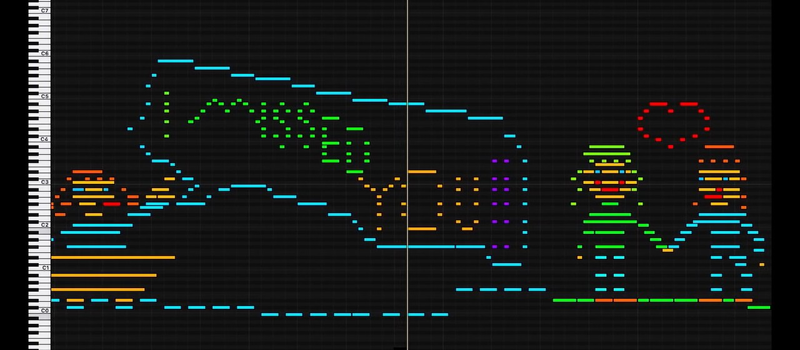Musician [Mari Lesteberg] is making music that paints pictures. Or maybe she’s making pictures that paint music. It’s complicated. Check out the video (embedded below) and you’ll see what we mean. The result is half Chinese scroll painting, and half musical score, and they go great together.
Lots of MIDI recorders/players use the piano roll as a model for input — time scrolls off to the side, and a few illuminated pixels represent a note played. She’s using the pixels to paint pictures as well: waves on a cartoon river make an up-and-down arpeggio. That’s a (musical) hack. And she’s not the only person making MIDI drawings. You’ll find a lot more on reddit.
Of course, one could do the same thing with silent pixels — just set a note to play with a volume of zero — but that’s cheating and no fun at all. As far as we can tell, you can hear every note that’s part of the scrolling image. The same can not be said for music of the black MIDI variety, which aims to pack as many notes into a short period of time as possible. To our ears, it’s not as beautiful, but there’s no accounting for taste.
It’s amazing what variations we’re seeing in the last few years on the ancient piano roll technology. Of course, since piano rolls are essentially punch-cards for musical instruments, we shouldn’t be too surprised that this is all possible. Indeed, we’re a little bit surprised that new artistic possibilities are still around. Has anyone seen punch-card drawings that are executable code? Or physical piano rolls with playable images embedded in them?
















It reminds me of scrolling 8 bit arcade games.
The music is quiet pleasant as well
I could definitely see someone doing a modern take on piano rolls, maybe as a children’s museum exhibit. Give kids a little roll of receipt paper and some markers, and have them draw a scene. Feed it through a scanner setup that tracks the color (instrument) and position (tone), and play back their creations!
Something similar was made 40 years ago by a (once famous) greek-french architect/mathematician/composer/genius named Iannis Xenakis, as a publicly funded, experimental and (somewhat) pedagogical tool :
“The UPIC, which stands for Unité Polygogique Informatique du CEMAMu was a tool that allowed you to translate drawings made on a common electronic whiteboard in a musical piece, similar to that used by many others CAD/CAM software.”
“Physically, the UPIC is a digitising tablet linked to a computer, which has a vector display. Its functionality is similar to that of the later Fairlight CMI, in that the user draws waveforms and volume envelopes on the tablet, which are rendered by the computer. Once the waveforms have been stored, the user can compose with them by drawing “compositions” on the tablet, with the X-axis representing time, and the Y-axis representing.”
http://www.musicainformatica.org/topics/upic.php
http://120years.net/upic-system-iannis-xenakis-france-1977/
It’s like the Holophonor!
these annoy me because many of the notes are just there for imagery and dont actually play sounds.
I’m not much for artsy-fartsy stuff, and it annoys me that many people are trying to turn STEM into STEAM, but this is cool. I’m considering reaching out for a hand-made Mario MIDI on a men’s t-shirt.
looks like my sons crayola light paint toy that spins
Some people on YouTube do these but they’re drawings of characters
is there a download?